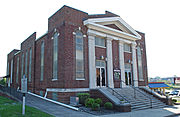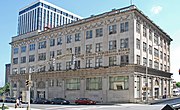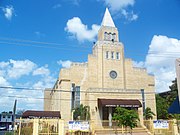
Pulaski is a city in and the county seat of Giles County, which is located on the central-southern border of Tennessee, United States. The population was 8,397 at the 2020 census. It was named after Casimir Pulaski, a noted Polish-born general on the Patriot side in the American Revolutionary War.

Marr & Holman was an architectural firm in Nashville, Tennessee known for their traditional design. Notable buildings include the Nashville Post Office and the Milliken Memorial Community House in Elkton, Kentucky.

Martin Luther King Jr. Academic Magnet for Health Sciences and Engineering at Pearl High School is a public magnet high school located in Nashville, Tennessee. MLK includes grades 7–12, and students enter through a lottery process similar to the other magnet schools in Nashville.

Joseph Warren Yost (1847–1923) was a prominent architect from Ohio whose works included many courthouses and other public buildings. Some of his most productive years were spent as a member of the Yost and Packard partnership with Frank Packard. Later in his career he joined Albert D'Oench at the New York City based firm D'Oench & Yost. A number of his works are listed for their architecture in the U.S. National Register of Historic Places (NRHP).

Hartwell and Richardson was a Boston, Massachusetts architectural firm established in 1881, by Henry Walker Hartwell (1833–1919) and William Cummings Richardson (1854–1935). The firm contributed significantly to the current building stock and architecture of the greater Boston area. Many of its buildings are listed on the National Register of Historic Places.

Bridgeforth High School in Pulaski, Tennessee, was Giles County, Tennessee's, first high school for African Americans. It opened in 1937. It was named for J. T. Bridgeforth, who was one of the earliest African-American educators in the county.

Capers C.M.E. Church, is a historic Christian Methodist Episcopal church built in 1925 in Nashville, Tennessee. It is also known as Caper Memorial Christian Church, and Capers Memorial C.M.E. Church.

The Baumann family was a family of American architects who practiced in Knoxville, Tennessee, and the surrounding region, in the late 19th and early 20th centuries. It included Joseph F. Baumann (1844–1920), his brother, Albert B. Baumann, Sr. (1861–1942), and Albert's son, Albert B. Baumann, Jr. (1897–1952). Buildings designed by the Baumanns include the Mall Building (1875), the Church of the Immaculate Conception (1886), Minvilla (1913), the Andrew Johnson Building (1930), and the Knoxville Post Office (1934).

Sanguinet & Staats was an architectural firm based in Fort Worth, Texas, with as many as five branch offices in Texas. The firm specialized in steel-frame construction and built many skyscrapers in Texas. The firm also accepted commissions for residential buildings, and designed many buildings listed on the National Register of Historic Places.

Lang & Witchell was a prominent architectural firm in Dallas, Texas, active from 1905 to 1942.

The Carnegie Library is a historic building on the Fisk University campus in Nashville, Tennessee. The cornerstone was laid in 1908 by William Howard Taft, who was then the U.S. Secretary of War. It was funded by Andrew Carnegie, who provided a number of academic libraries, as well as many public Carnegie libraries.
Edward Emmett Dougherty, a.k.a. Edwin Dougherty was an architect in the southeastern United States. One of his best known designs was the Tennessee War Memorial Auditorium in Nashville in 1922. The work won state and national design competitions.

The Morris Memorial Building is a historic building in Nashville, Tennessee, United States. It was built in the 1920s for the African-American National Baptist Convention, USA, Inc. and was named for longtime president Elias Camp Morris.
African-American architects are those in the architectural profession who are African American in the United States. Their work in the more distant past was often overlooked or outright erased from the historical records due to the racist social dynamics at play in the country, but the black members of the profession—and their historic contributions—have become somewhat more recognized since.

The Hubbard House is a historic house in Nashville, Tennessee, U.S.. It was built in 1921 by architecture firm McKissack and McKissack for Dr. George W. Hubbard, the then-president of Meharry Medical College, an African-American medical school. It was built on its original campus, and its construction was funded by trustees and alumni.
Rush, Endacott and Rush was an American architectural firm known for its designs in Tulsa, Oklahoma, from 1912 to 1929.
Edwin Augustus Keeble was an American architect who was trained in the Beaux-Arts architecture tradition. He designed many buildings in Tennessee, including homes, churches, military installations, skyscrapers, hospitals and school buildings, some of which are listed on the National Register of Historic Places. He is best known for Nashville's landmark Life and Casualty Tower built in 1957 which was the tallest commercial structure in the Southeastern United States at that time. It reflected an architectural turn to modernism and was one of the first buildings emphasizing energy efficiency.
Moses McKissack III (1879–1952), was an American architect. He had his own architecture firm McKissack Company from 1905 until 1922, and was active in Tennessee and Alabama. In a partnership with his brother Calvin Lunsford McKissack, they founded the architecture firm McKissack & McKissack in 1922.

The D.R. Glass Library, or Dominion Robert Glass Library, is a historic building and academic library built in 1948, and located at the Texas College campus at 2404 North Grand Avenue, Tyler, Texas. It is listed on the National Register of Historic Places since March 7, 2007.

Cheryl McKissack Daniel is an American civil engineer and businesswoman. She is the president and chief executive officer of McKissack & McKissack, a design and construction company founded by her grandfather Moses McKissack III and granduncle Calvin Lunsford McKissack.





















